East Sussex wartime writers and artists (4)
Posted: 22 January 2014 21:06
Burwash is most famous for an author whose books bore swastikas until the 1930's, but the Second World War saw a few more writers and artists plying their trade in the area.
The wartime activity around the village hasn't received the prominence it deserves; something I aim to set right over two posts.
Rudyard Kipling
Rudyard Kipling needs no introduction as a leading poet and author of works such as Kim, The Jungle Book and Just So Stories.
Living first in Rottingdean near Brighton before moving to Burwash in 1902, Kipling's death in 1936 makes his inclusion in this series a bit tenuous, but his works and memory create some interesting connections to the Second World War.
Of course, there is plenty of evidence from Kipling's lifetime in East Sussex; aside from his former residences, the name of his son, Lt. John Kipling, can be seen on the Burwash war memorial below. The death of his beloved son at the Battle of Loos in 1915 profoundly affected Kipling, who had personally intervened to secure his son's acceptance into the Irish Guards.
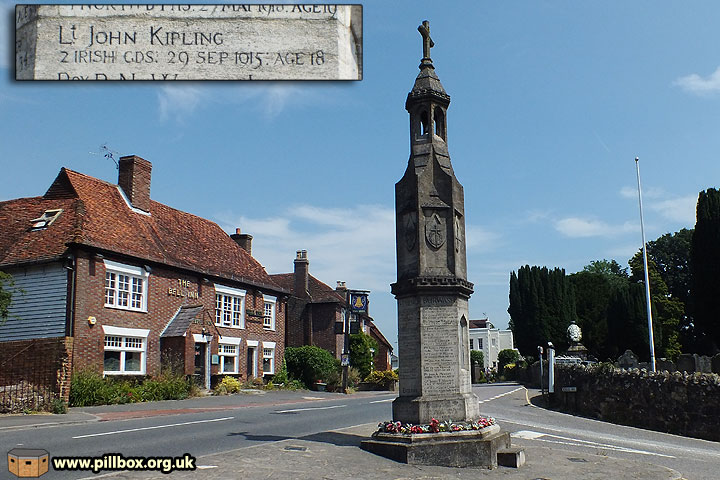
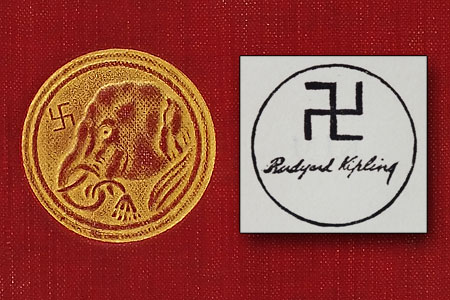
Some people today find it odd that Kipling had been using the swastika on his publications since the 1890s, and make an understandable, but misinformed, connection with 20th century Fascism.
The graphic at right shows part of the cover of a 1901 copy of Kim inset with part of the title page.
Holding a lotus flower in his trunk is the elephant-headed Hindu God, Ganesha, who represents intellect and wisdom.
The use of the swastika on earlier editions of Kipling's work was completely innocent; as a Hindu good luck symbol, it was in common use when Kipling was using it.
The Nazis adopted the swastika as their logo in 1920, with Hitler adding it to the Nazi flag after his rise to power in 1933.
As a result, Kipling, disgusted at Nazism, ordered that the symbol that he had used for nearly 40 years be discontinued on all future editions of his works.
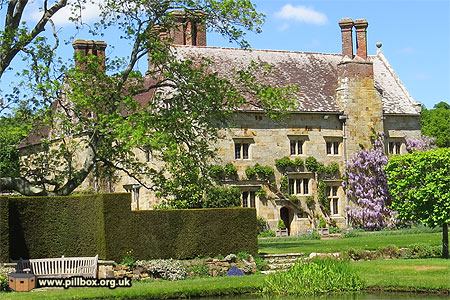
The house that Kipling bought at Burwash was Bateman's, a Jacobean mansion built in 1634, shown in the photo at left.
It should be remembered that Kipling was (and still is) iconic; indeed, one of the reasons he moved to Bateman's was to escape the busloads of tourists turning up at his gate in Rottingdean.
Kipling's wife, Carrie, bequeathed Bateman's to the National Trust upon her death in 1939, as a memorial to her husband and so tourists were able to see the house and grounds much as Kipling had left them.
The arrival of Canadian soldiers in England represented a new wave of heritage tourism. Fascinated by the history of their new surroundings in Sussex, a war diary in the National Archives shows that Bateman's was on the itinerary of trips organised by the Canadian Legion Educational Services in June 1943.
The National Trust still opens Bateman's to the public: https://www.nationaltrust.org.uk/batemans/
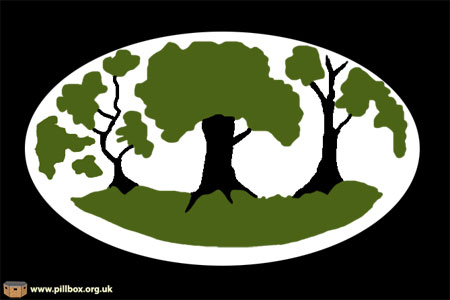
Visible from Bateman's is Pook's Hill, the inspiration for Kipling's 1906 book Puck of Pook's Hill.
It was this work that influenced the design of the insignia shown at right.
This was the formation sign of XII Corps who were responsible for the defence of East Sussex and part of Kent in 1940.
In June 1940, the Corps was being raised in what Lt. Col. H. M. Cole's 1947 guide to formation badges, Heraldry in War, calls "Pook's Hill Country."
The Commanding Officer of XII Corps was Maj-Gen Andrew Thorne, and so the "Oak and Ash and Thorn" (trees sacred to Druids) from Kipling's A Tree Song are depicted on the shoulder flash.
Yew that is old in churchyard mould,
He breedeth a mighty bow;
Alder for shoes do wise men choose,
And beech for cups also.
But when ye have killed, and your bowl is spilled,
Your shoes are clean outworn,
Back ye must speed for all that ye need,
To Oak and Ash and Thorn!
Could XII Corps' founding Officers have read the British Expeditionary Force speeding back from Dunkirk 'for all that ye need' into the above passage?
The Corps moved wholly into Kent in 1941; in 1944 it formed part of 21st Army Group in the assault on Europe, advancing through France, Belgium and Germany, carrying with it Kipling's "Oak and Ash and Thorn" all the way from Burwash.
But it wasn't just the Army finding inspiration in Kipling; the Home Guard also sought patriotic vigour in his verse. In his book, Home Guard Warfare, John Langdon-Davies (whose works we shall study in due course) wrote:
"To me, as to nearly all members of the Home Guard, the most inspiring thing about our duties is that they are local. We are to defend our own plot of ground. Now, I live in Sussex, almost next door to the house where Kipling lived, and I often find myself echoing, as I do my Home Guard duties, Kipling's words:
God gives all men all earth to love,
But since man's heart is small,
Ordains for each one spot shall prove
Beloved over all.
Each to his choice, and I rejoice
The lot has fall to me
In a fair ground - In a fair ground
Yea, Sussex by the Sea!"
Langdon-Davies had originally published this in the Sunday Pictorial, broadcasting Kipling's words to inspire Home Guards the length and breadth of the country in time of national crisis.
Roland Penrose
As a Quaker and conscientious objector, Roland Penrose had served with the Friends Ambulance Unit and the British Red Cross in the final months of the Great War.
His continuing pacifism lead him to enrol as an ARP Warden in Hampstead after the outbreak of war in 1939, but employed his skills as a surrealist artist to teach the techniques of camouflage at a private Home Guard training school established at Osterley Park, London.
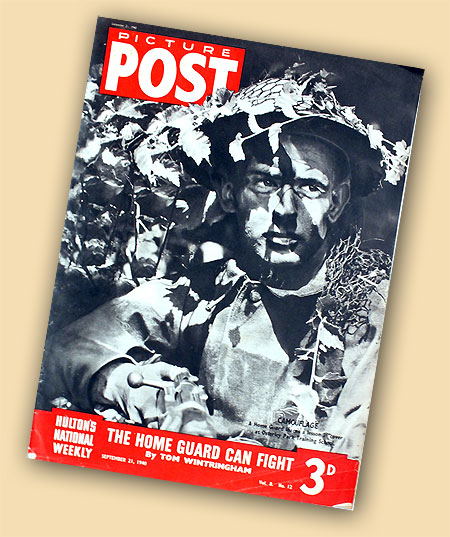
The school was founded in June 1940 by Tom Wintringham, a veteran of the Spanish Civil War who had originally set out to cover the hostilities as a journalist. However, he ultimately found himself commanding the British Battalion of the International Brigades fighting against the Fascists.
A Picture Post article by Wintringham in the 21 September 1940 edition described the activities at Osterley.
The front cover (shown at right) featured Penrose's handiwork in the form of a Home Guard camouflaged with vegetation and facepaint.
The article included photographs and pen-pictures of the key instructors, Penrose being described thus:
Lecturer and practitioner in camouflage. By profession, he is a member of an organisation carrying out camouflage schemes for factories and Government departments. By training, he is a surrealist painter. He has exhibited his modern paintings all over the world. In his spare time he teaches the principles of successful camouflage to members of the Home Guard.
The War Office disapproved of the Osterley Park school (due to the predominantly left-wing politics of the staff there, even though Wintringham had been expelled from the Communist Party in 1938) and had taken it over just before the above article was published.
Osterley Park was finally closed in June 1941 and its staff dispersed to official Home Guard Schools.
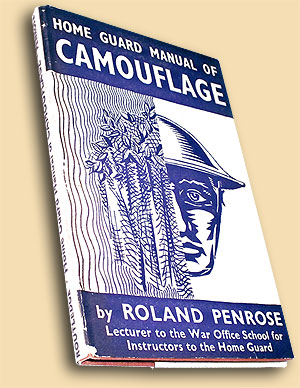
Penrose's precise whereabouts around this time are not clear due to conflicting sources. Having been commissioned into the Royal Engineers as a Captain, he seems to have been at an Eastern Command Camouflage School in Norwich and the Camouflage Development and Training Centre at Farnham Castle in Surrey.
It was at the latter establishment (mentioned in his author's note) that probably he wrote his Home Guard Manual of Camouflage, shown at left.
First published in October 1941, the manual described camouflage and deception in Nature, siting and concealment of defence works, dummies and decoys, track discipline and personal camouflage.
The manual must have been popular; the dust jacket claims that it was "officially approved by the War Office" and by April 1942, it was on its fifth impression.
The title page lists Penrose's previous position at Osterley Park, and describes his current appointment as "Lecturer to the War Office School for Instructors to the Home Guard."
Penrose's lectures included nude photographs of his partner, American journalist and photographer Lee Miller, painted green with her modesty covered by camouflage netting and hessian scrim.
Lee Miller went on to cover the story of the London Blitz and the harrowing stories of the Buchenwald and Dachau concentration camps. She was famously photographed in Hitler's bath in his Munich apartment on the same day that he shot himself in Berlin.
In 1949 Penrose and Miller (married since 1947), bought Farley Farm at Chiddingly, East Sussex, where they stayed until their deaths, Miller in 1977 and Penrose seven years later.
It wasn't until recently that I realised that Penrose had actually been in East Sussex during the war. While doing some research for this series, I happened to see a Captain Roland Penrose described as Camouflage Officer at the South Eastern Command Home Guard Fieldcraft School at Burwash in February 1942.
This name-check appeared in the introduction to The Home Guard Fieldcraft Manual, which was based on the experience gained from training exercises held at the Fieldcraft School.
The author of this manual was the Commandant of the school, John Langdon-Davies (who quotes Kipling above), but before we examine his extensive bibliography in the next part in this series, we'll have a taster of the Home Guard Fieldcraft School at Burwash from the final author in this part.

A.G. Street
Arthur George Street was a broadcaster and author, predominantly writing on agriculture as a result of his farming experience.
His February 1943 book From Dusk Till Dawn (left), grafts factual events onto the fictional (but average rural) Sedgebury Wallop platoon of the Wessex Home Guard in Wiltshire, presumably in order to spare blushes and avoid security issues.
Interspersed with these pseudo-fictional episodes are the author's real-life experiences, and the most important aspect of the book for us is his four-page description of the Burwash Home Guard School.
Street met John Langdon-Davies over lunch in London in December 1941, and subsequently found himself the following Friday on the next weekend course at Burwash.
At 22:00 hours the intake of 50 Home Guards from all over the country paraded in a barn in Burwash, were detailed into sections, and introduced to the nature of the course. The men dispersed an hour later to sleep rough in lofts and outbuildings.
Next morning, daily rations were issued - bully beef, tea, potatoes and bread. After a weapons inspection, lectures were held in the barn, followed by outdoor exercises.
The rule that at all times we must behave as though under fire from Burwash seemed at first to be rather an unnecessary joke, but soon it became an accepted part of our lives. To obey it properly, even if one wanted merely to cross the narrow gap between the barn and an outhouse, one must crawl in the mud....By nightfall on the first day we looked a sorry lot of scarecrows. Truly, stout middle age crawling on its belly to procure a light for a cigarette presented a weird spectacle...
A fair description of that course was that it was tough but great fun. The water-supply was by well and bucket, the lighting by oil hurricane lanterns. The latter was a great blessing, as it meant that after dark training and lectures must stop, and this enabled a gang of unshaven toughs to visit the pub at Burwash and drown some of their aches and pains in beer.
Street found the overall experience of the course invigorating:
"I came away convinced that such training was very necessary for the average Home Guard. It stirred his imagination, and enabled him to picture possible war conditions and how best to work under them....Neither before or since had I been so cold and hungry, or so possessed of the zest for living and working."
John Langdon-Davies
The impressive array of titles shown below are just a few of those written by John Langdon-Davies during his time at Burwash. His contribution is such that he deserves a separate post, and so part 5 of this series will be devoted to his works.
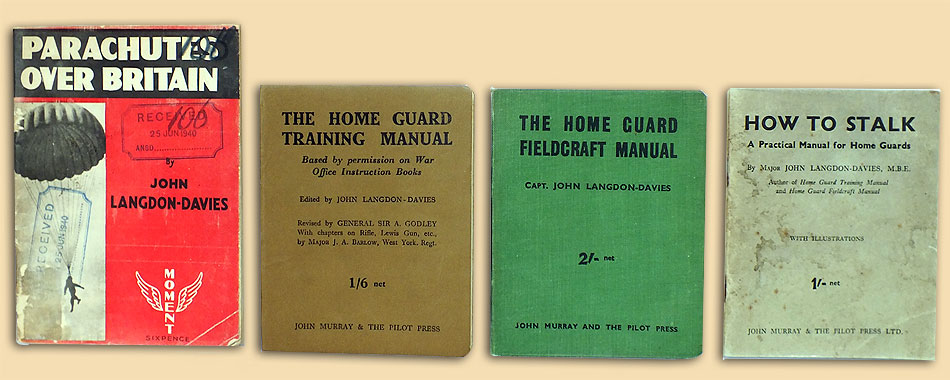
- Pete

Email:
Blog Latest

Bishopstone reveals its pillbox secrets
18 October 2021

Pillbox or Observation Post?
10 June 2020

Uncovering the hidden secrets of a pillbox
8 June 2019

Review of 2018
31 December 2018

Wartime Christmas in East Sussex (2)
24 December 2018
Jargon-buster
War diary
A record of events kept by all units from the point of mobilisation. A diary's contents vary enormously from unit to unit; some give detailed entries by the hour on a daily basis while others merely summarise events on a weekly/monthly basis.
This site is copyright © Peter Hibbs 2006 - 2024. All rights reserved.
Hibbs, Peter East Sussex wartime writers and artists (4) (2024) Available at: http://www.pillbox.org.uk/blog/216736/ Accessed: 18 April 2024
The information on this website is intended solely to describe the ongoing research activity of The Defence of East Sussex Project; it is not comprehensive or properly presented. It is therefore NOT suitable as a basis for producing derivative works or surveys!